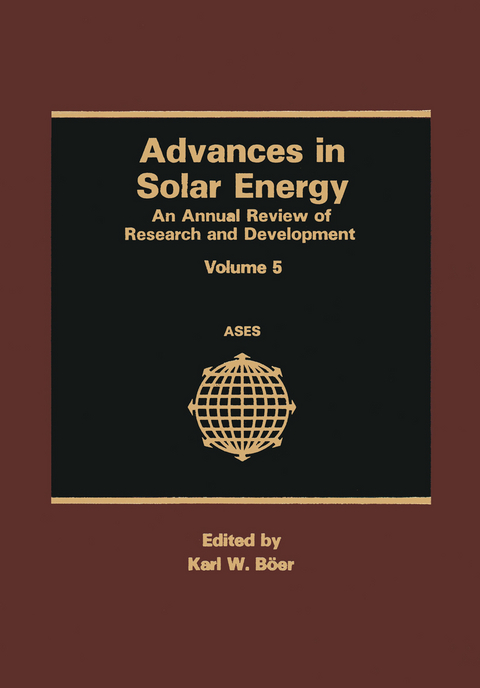
Advances in Solar Energy
Springer-Verlag New York Inc.
978-1-4612-8107-8 (ISBN)
1 Amorphous Silicon Solar Cells.- 1.1 Introduction.- 1.2 Unique Advantages of ?-Si Solar Cell.- 1.3 Structure and Electronic Density of States.- 1.4 Film Deposition and Valency Control of ?-Si and Its Alloys.- 1.5 Carrier Transport and Drift Type Photolovtaic Effect in ?-Si.- 1.6 Characterization of Material and Junction Properties.- 1.7 Key Technologies for Improving Efficiency.- 1.8 Heterojunction Solar Cell.- 1.9 ?-Si Basis Stacked Solar Cell.- 1.10 Staebler-Wronski effect.- 1.11 Light Induced Degradation of ?-Si Solar Cell.- 1.12 Aspect of Application Systems.- 1.13 Conclusion.- 1.14 References.- 2 Advances in Solar Optical Materials.- 2.1 Abstract.- 2.2 Introduction.- 2.3 Antireflection Films.- 2.4 Metallic Reflector Materials.- 2.5 Solar Selective Absorbers.- 2.6 Radiative Cooling Materials.- 2.7 Transparent Low-Emittance Coatings.- 2.8 Fluorescent Concentrators.- 2.9 Spectral Splitting and Cold Mirror Films.- 2.10 Transparent Aerogel and Polymeric Transparent Insulation.- 2.11 Optical Switching Materials and Devices.- 2.12 Prismatic Light Guides.- 2.13 Holographic Films.- 2.14 Conclusions.- 2.15 Acknowledgements.- 2.16 References.- 3 A Solar Hydrogen Energy System.- 3.1 Introduction.- 3.2 Available Solar Energy.- 3.3 Direct Methods for Collecting Solar Energy.- 3.4 Indirect Solar Energy Collection.- 3.5 Splitting of Water.- 3.6 Transmission of Hydrogen.- 3.7 Storage of Hydrogen.- 3.8 Present Uses of Hydrogen.- 3.9 Proposed Uses of Hydrogen.- 3.10 Projected Economics of Hydrogen Production.- 3.11 References.- 4 Wind Technology Today.- 4.1 Introduction.- 4.2 Analytical Design Theory.- 4.3 Design Issues and Tradeoffs.- 4.4 Control Systems.- 4.5 Current Wind Turbines and Their Performance.- 4.6 Experimental and Research Wind Turbines.- 4.7 Performance of CurrentSystems.- 4.8 Design and Reliability Problems.- 4.9 Drive Train and Electrical Problems.- 4.10 Yaw Drive.- 4.11 Tower Failures.- 4.12 Wind Power Resources, Applications and Economics.- 4.13 Public Acceptance of Wind Power Development.- 4.14 Environmental Impact Issues.- 4.15 Current Research and Development Programs.- 4.16 Acknowledgements.- 4.17 References.- 5 Retrofit for Solar Heating and Cooling.- 5.1 Abstract.- 5.2 Introduction.- 5.3 Typical Retrofit Systems.- 5.4 The Housing Stock Suitable for Retrofit.- 5.5 The Potential for Saving Depletable Energy and Reducing Pollution.- 5.6 The Impact on Customers.- 5.7 The Technical Aspects.- 5.8 Economics of Retrofit.- 5.9 Financing Methods.- 5.10 Barriers and Incentives.- 5.11 Retrofit System Demonstrations and Performance Monitoring.- 5.12 Education and Technology Transfer.- 5.13 Research and Development Needs.- 5.14 Conclusions and Major Recommendations.- 5.15 Acknowledgements.- 5.16 References.- 6 Bioclimatic Design Research: The Basis of Environmental Architecture.- 6.1 Historic Overview: The development of an idea.- 6.2 Bioclimatic Analysis and Design Strategies.- 6.3 Examples of Bioclimatic Analysis and Design.- 6.4 The Whole Building and Site as a Bioclimatic System.- 6.5 Bioclimatic Design Principles of Environmental Architecture.- 6.6 References.
| Erscheint lt. Verlag | 1.10.2011 |
|---|---|
| Reihe/Serie | Advances in Solar Energy ; 5 |
| Zusatzinfo | 470 p. |
| Verlagsort | New York, NY |
| Sprache | englisch |
| Maße | 170 x 244 mm |
| Themenwelt | Sachbuch/Ratgeber ► Natur / Technik ► Garten |
| Naturwissenschaften ► Physik / Astronomie | |
| Technik ► Elektrotechnik / Energietechnik | |
| Technik ► Maschinenbau | |
| ISBN-10 | 1-4612-8107-5 / 1461281075 |
| ISBN-13 | 978-1-4612-8107-8 / 9781461281078 |
| Zustand | Neuware |
| Haben Sie eine Frage zum Produkt? |
aus dem Bereich


